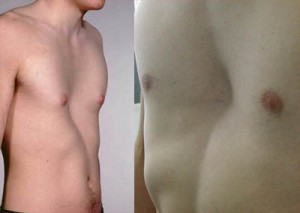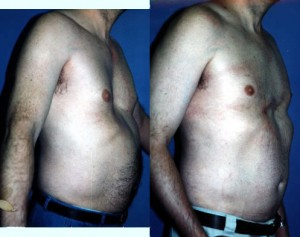Pectus excavatum Definition
Page Contents
- 1 Pectus excavatum Definition
- 2 Pectus excavatum Incidence
- 3 Pectus excavatum Causes
- 4 Pectus excavatum Symptoms
- 5 Pectus excavatum Diagnosis
- 6 Pectus excavatum Treatment
- 7 Benefits of PE Surgical Treatment
- 8 Pectus excavatum Complications
- 9 Pectus excavatum Risk Factors
- 10 Can Pectus excavatum be Serious?
- 11 When to Seek Treatment for PE?
Physicians and medical researchers define Pectus excavatum (PE) as a congenital defect of the chest wall characterized by a sunken middle section of the chest. In this condition, the sternum as well as several ribs has an abnormal growth which gives the chest its sunken appearance.
The disorder is also referred to as “Hollowed chest”, “Funnel chest” or “Sunken chest.” The name “Pectus excavatum” is actually a Latin word that stands for “hollowed chest.”
Pectus excavatum Incidence
PE is a quite common congenital defect that accounts for around 90% birth deformities of the chest wall. Around 40% patients of this disorder have at least one family member with the problem. The condition affects males more than females. It is evident in one out of every 300-400 white males born annually.
Pectus excavatum Causes
It is not clear what exactly leads to the development of this disease. Medical researchers are, however, of the opinion that the deformity results from an excessive growth of the cartilage which is responsible for joining the costochondral region (breastbone) to the ribs. This results in the inward turning of the sternum.
Picture 1 – Pectus excavatum
Most cases of this condition are not found to be associated with any disorder. However, some cases may be the result of certain diseases. These include:
Scoliosis
It is characterized by a curved spinal column.
Marfan Syndrome
It is a disorder of the connective tissue that results in abnormalities of the skeletal system. It is typically characterized by:
- Abnormalities of the chest
- Spider-like appearance of fingers
- Long limbs
- Crowded teeth
- Curved spine
- Facial defects, that comprise of a highly arched palate
Rickets
It is a deficiency disorder that mainly affects children. It occurs due to a deficiency of calcium or vitamin D resulting from inadequate exposure to sunlight. It disturbs normal growth of the bones.
The condition may also arise due to the presence of other disorders like Familial Pectus excavatum and Poland Syndrome. It often originates by itself even in the absence of any family history or any other defect or abnormal condition.
Pectus excavatum Symptoms
The disorder results in a depression or concavity in the middle of the chest, in the region above the sternum. The depression may be quite deep in appearance.
The majority of people affected by this condition are asymptomatic, aside from the abnormality of their chest. In other words, they do not exhibit any signs or symptoms characteristic of the syndrome. Only a small percentage of sufferers experience the following problems:
- Chest pain
- Fatigue
- Rapid heart rate (Tachycardia)
- Shortness of breath
If PE turns severe, it can affect the lungs and heart of sufferers. This can make it difficult for them to work out. The abnormal appearance of their chest may also have a negative impact on the psychology of kids affected by the syndrome.
This condition may occur by itself, or along with other syndromes. PE patients are also found to suffer from a cardiac problem known by the name “Mitral Valve Prolapse.”
Pectus excavatum Diagnosis
The condition must be accurately diagnosed before it can be treated. The initial stages of diagnosis involve a team comprising of a physician, a pulmonologist and a thoracic surgeon who conduct comprehensive blood tests and a complete physical examination to confirm the presence of this disorder.
Some other tests, that might be necessary for the diagnosis of this condition, include:
- Pulmonary function test
- Chest x-ray
- Physical stress exam
- Lab studies like enzyme assays or chromosome studies
- Echocardiogram (cardiac imaging)
- Electrocardiogram (EKG)
- Metabolic studies
- CT (Computed tomography) scan of the chest
However, physicians can generally diagnose PE by a simple examination of the chest.
Pectus excavatum Treatment
The majority of PE sufferers being asymptomatic, there might not be a need for treatment. Medical cure may depend on the signs and symptoms of the condition exhibited by patients. In young sufferers, especially those under 18 years of age, physical therapy might be necessary. This is due to the fact that PE deformities tend to remain the same after this age. Physical therapy might help slow down the progression of the chest wall deformity and even reverse some of the defects of the chest structure.
In case the deformities compromise the health of the heart or any of the lungs in a sufferer, he or she might be recommended surgery. As per medical research, surgical repair has been found to improve the functioning of the blood vessels and the heart significantly.
Surgery helps correct the deformities of the chest and improves the posture, cardiac function and respiration of affected individuals. Surgeons typically do this by removing a part of the malformed cartilage and repositioning the sternum (breastbone).
The two most common operative methods for this problem include:
Smaller incisions
This is a minimally invasive technique in which smaller slits or incisions are made under each arm, on either side of the chest. The process involves insertion of a narrow fiber-optic camera and long-handled equipments through the slits. A curved metal bar is threaded below the depressed sternum to elevate it to a position that is better and more normal. In a few cases, multiple bars are used instead of a single one. These are taken off after a couple of years.
Larger incision
It involves making a larger slit at the centre of the chest to let surgeons have a direct glimpse of the breastbone. In this method, the abnormal cartilage (that joins the ribs to the sternum) is removed. Surgical instruments like mesh supports and a metal strut are used to fix the sternum to a more normal position. These are taken off after a period ranging anywhere from nine to twelve months.
Benefits of PE Surgical Treatment
The surgical techniques used for remedying PE, such as the NUSS procedure, are more advantageous as compared to traditional operative methods. PE patients who undergo such techniques have reduced postoperative pain and also have a shorter hospital stay. They can also recover more rapidly and go back to work much faster than normal patients who have been operated on. Reduced bleeding and lower risk of infection are some other possible benefits.
The Ravitch technique, which is an advanced form of surgical repair, offers the following advantages:
Picture 2 – Pectus excavatum Image
- Reduced postoperative pain
- Decreased risk of complications
- Reduced post-operative hospital stay, rarely extending more than five days
Pectus excavatum Complications
The condition has a few complications associated to it. Severe cases of PE can push the heart to a side and squeeze the lungs. Severely deep indentation of the sternum might reduce the space normally required by the lungs to expand. The squeezing of the lungs is often found to push the heart to the left side of the chest and impair its ability to pump in an efficient manner.
In some individuals, the depth of indentation tends to worsen in the initial stages of adolescence and can worsen in the adult stages.
Surgical Complications of Pectus excavatum
Like other extensive operative techniques, the surgical repairing procedures for PE are also associated with a number of complications. Such surgical complications include:
- Bleeding
- Infection
- Pleural effusion (fluid accumulation in the region surrounding the lungs)
- Bar displacement
- Pneumothorax (buildup of gas or air in the pleural space)
In case the surgical repair is carried out too early, even before puberty, there can be a recurrence of PE. The condition may also recur if the bar or strut is left in place for too long.
Psychological complications of Pectus excavatum
Kids suffering from PE are found to have a hunched-forward posture. They have flared shoulder blades and ribs. Many of them are conscious about their body image and tend to suffer from a sense of inferiority. This makes them avoid activities like swimming which requires exposing the chest area.
In their teen years, PE patients want to fit into their peer groups and wish to look normal. This is, however, quite impossible for individuals affected with this chest condition. Certain sufferers may require counseling to adapt techniques to cope with the problem. Various online forums and support groups are available that can help PE patients and their family members get in touch and discuss with people suffering from similar problems.
Pectus excavatum Risk Factors
No specific risk factors have yet been found to be associated to this condition. However, the disorder is observed to be more common in boys than in girls.
Can Pectus excavatum be Serious?
In rare cases, PE can result in compression of the lungs and the heart if left untreated. The condition cannot be prevented. Fortunately, it can be treated.
When to Seek Treatment for PE?
Patients should seek medical attention if they experience any of the following problems, which may impair their daily activities:
- Respiratory difficulties
- Chest pain
- Inflammation, redness or discharge from the region
- Persistent depression or anger about the problem
- Reduced tolerance to exercise
If you have PE and are suffering from such problems, seek medical attention as soon as possible. Earlier diagnosis and treatment would help you make a faster recovery from this condition and evade all possible complications in future.
References:
http://www.mayoclinic.com/health/pectus-excavatum/DS01136
http://en.wikipedia.org/wiki/Pectus_excavatum
http://my.clevelandclinic.org/disorders/pectus_excavatum/hic_pectus_excavatum.aspx
http://www.nlm.nih.gov/medlineplus/ency/article/003320.htm
http://emedicine.medscape.com/article/1004953-overview


